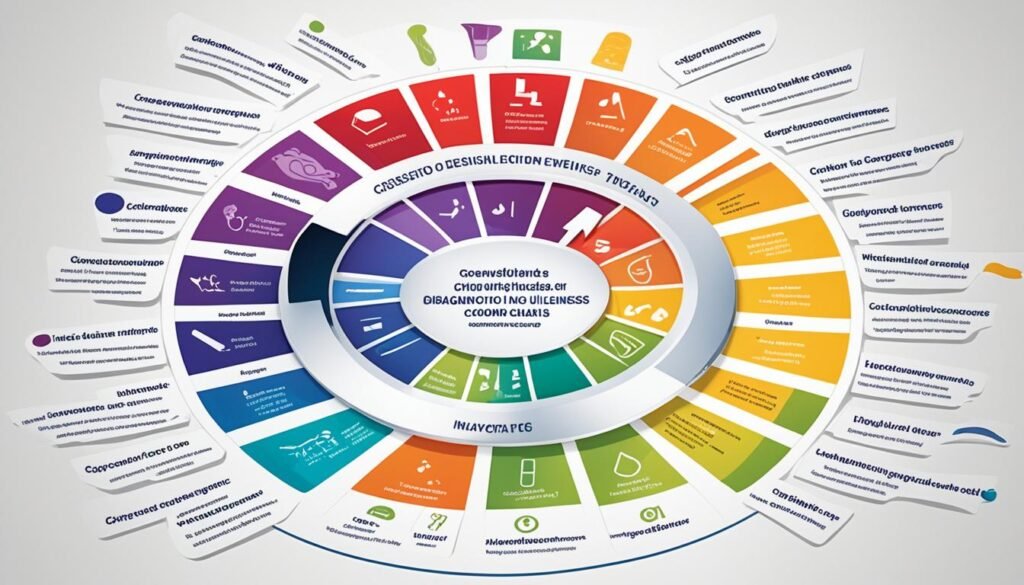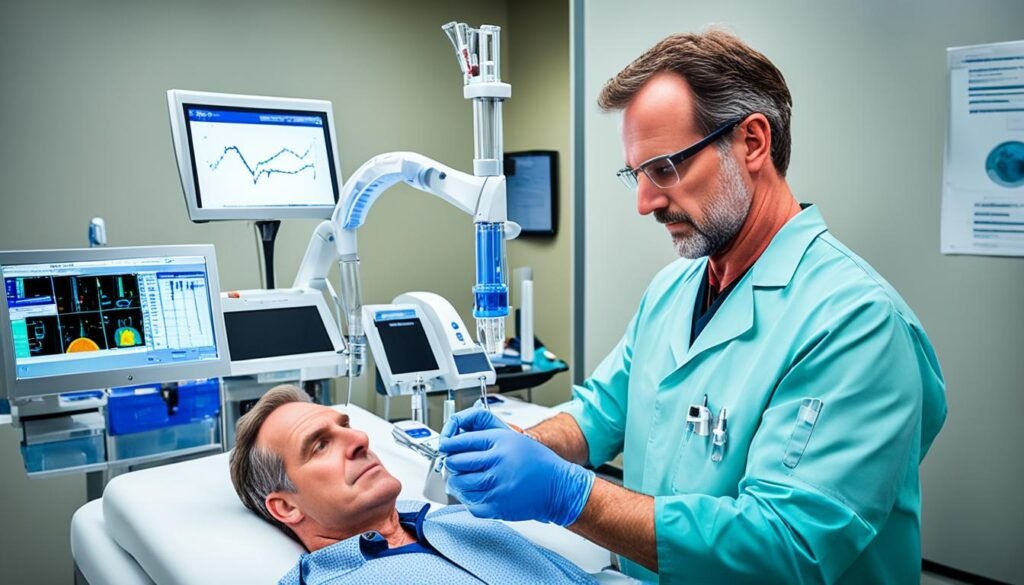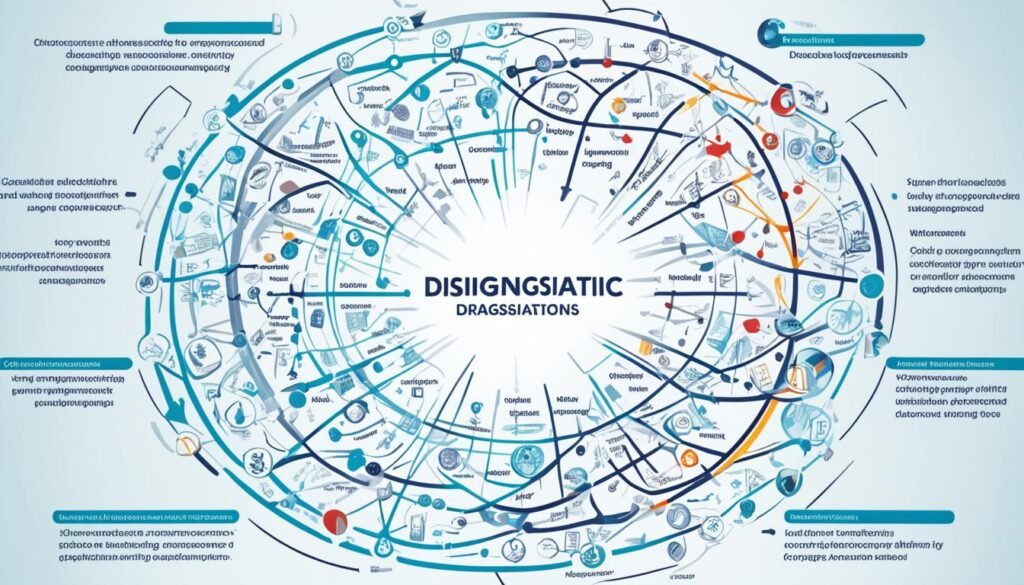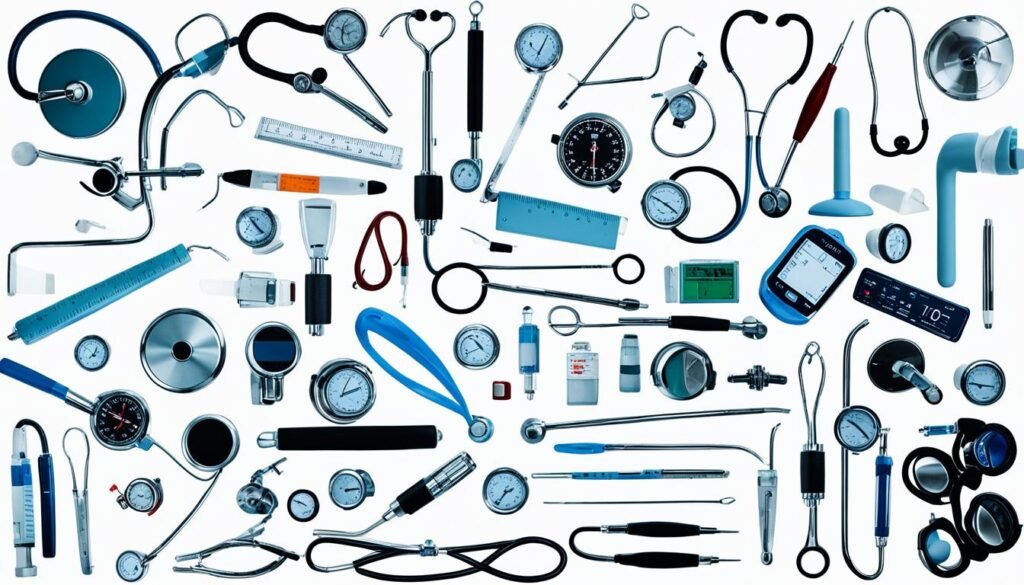Guide To Diagnosis : In this comprehensive guide, we will delve into the intricacies of the diagnostic process, providing valuable insights and an overview of the medical diagnosis guide. By unraveling health mysteries, we aim to equip you with the knowledge and understanding necessary for accurate diagnoses.
Key Takeaways:
- Understanding the diagnostic process is essential for accurate diagnoses
- Our guide will provide valuable insights and an overview of the medical diagnosis process
- Unraveling health mysteries requires knowledge and understanding
- Accurate diagnoses are crucial for effective healthcare
- Stay tuned for an in-depth exploration of diagnostic procedures and tools
The Importance of Diagnosis
Proper diagnosis is a cornerstone of effective healthcare. It is a process that involves careful examination and evaluation of symptoms, medical history, and test results to identify and understand the underlying cause of a health condition. Diagnostic practices provide valuable insights into patients’ health and enable healthcare professionals to develop appropriate treatment plans.
Accurate diagnosis is essential for several reasons. For patients, it determines the course of their treatment, which can significantly impact their overall well-being and quality of life. Additionally, an accurate diagnosis allows patients to have a better understanding of their condition, giving them the opportunity to make informed decisions about their health.
From a healthcare perspective, a precise diagnosis is crucial to avoid misdiagnosis or delayed diagnosis, which can result in unnecessary treatments or potential risks to the patient’s health. It also helps healthcare professionals monitor the effectiveness of treatments and make adjustments as needed.
“A good physician treats the disease; a great physician treats the patient who has the disease.” – Sir William Osler
Obtaining accurate diagnoses requires healthcare professionals to employ a systematic approach, utilizing a combination of diagnostic tools, clinical skills, and medical knowledge. Valuable insights gained from diagnostic processes can lead to a more comprehensive understanding of patients’ conditions and guide appropriate treatment decisions.
Tips for Achieving Accurate Diagnoses
Here are some tips to enhance diagnostic accuracy:
- Thoroughly review the patient’s medical history and listen attentively to their symptoms and concerns.
- Conduct a comprehensive physical examination, paying attention to any abnormal findings.
- Order laboratory tests, imaging studies, or other diagnostic procedures based on the patient’s symptoms and suspected condition.
- Collaborate with other healthcare professionals, such as specialists or consultants, to gain insights from diverse perspectives.
- Stay updated with the latest research and advancements in medical knowledge and diagnostic techniques.
By integrating these diagnostic practices into their approach, healthcare professionals can improve accuracy and ensure patients receive the most appropriate care.
As the diagnostic process continues to evolve, it is important to recognize its significance in guiding healthcare decisions and improving patient outcomes. Emphasizing the importance of accurate and timely diagnosis leads to enhanced patient care and contributes to a healthier society.
Overview of the Guide To Diagnosis Process
The diagnostic process is a systematic and essential step-by-step guide in healthcare that helps identify and determine the nature of a health condition. By following a well-defined diagnosis protocol checklist, healthcare professionals can effectively unravel health mysteries and make accurate diagnoses.
Here is an overview of the diagnostic process:
- Medical History: Gathering a patient’s medical history is the initial step in the diagnostic process. It provides valuable insights into their past health conditions, medications, allergies, and family history, aiding in diagnosis.
- Physical Examination: Conducting a thorough physical examination allows healthcare professionals to assess vital signs, examine specific body systems, and identify any abnormal physical findings that may indicate an underlying condition.
- Diagnostic Tests: Depending on the specific symptoms and medical history, healthcare professionals may order diagnostic tests to gather more information and confirm or rule out potential diagnoses. These tests can include blood tests, imaging studies, biopsies, and more.
- Interpreting Results: Once the diagnostic tests are completed, healthcare professionals carefully analyze and interpret the results. They compare them with normal ranges and diagnostic criteria to assess the presence of a specific condition.
- Consultation: In complex cases, healthcare professionals may seek the expertise of specialists or other healthcare professionals to gain additional insights and opinions regarding the diagnosis.
- Formulating a Diagnosis: Based on the patient’s medical history, physical examination, diagnostic test results, and consultation, healthcare professionals formulate a diagnosis. This diagnosis is informed by the step-by-step diagnosis guide and follows established diagnostic protocols.
- Treatment Plan: Once a diagnosis is confirmed, healthcare professionals develop a treatment plan tailored to the patient’s specific condition. The plan may include medication, surgery, lifestyle changes, or other interventions.
- Monitoring and Follow-up: After initiating treatment, healthcare professionals closely monitor the patient’s progress and make necessary adjustments. Regular follow-up appointments ensure the effectiveness of the treatment and allow for any necessary modifications.
“The diagnostic process is like assembling a puzzle. Each step brings us closer to uncovering the root cause of a patient’s symptoms, helping us provide the best possible care and treatment.”
Exploring Diagnostic Tests
Diagnostic tests are essential tools in the process of diagnosing various illnesses. They help healthcare professionals gather important information and make accurate assessments. In this section, we will delve into the different types of diagnostic tests, providing explanations of their purpose and offering tips for achieving accurate diagnoses.
The Role of Diagnostic Tests
Diagnostic tests play a crucial role in identifying and understanding the underlying causes of health conditions. They provide valuable insights into the functioning of the body’s systems, helping healthcare professionals make informed decisions about treatment plans.
“Diagnostic tests are like puzzle pieces that fit together to form a complete picture of a patient’s health.”
By analyzing the results of diagnostic tests, healthcare professionals can establish a baseline for comparison, monitor the progression of illnesses, and evaluate the effectiveness of treatments. These tests assist in developing accurate diagnoses, leading to appropriate and timely interventions.
Types of Diagnostic Tests
There are various types of diagnostic tests, each designed to provide specific insights into different aspects of a patient’s health. Some common diagnostic tests include:
- Imaging tests, such as X-rays, MRIs, and CT scans, which allow healthcare professionals to visualize internal structures and detect abnormalities.
- Laboratory tests, including blood tests, urine tests, and genetic tests, which analyze samples to identify markers of specific diseases or conditions.
- Biopsy tests, which involve the removal of a small sample of tissue for further analysis to determine the presence or extent of diseases, such as cancer.
Tips for Accurate Diagnosis
While diagnostic tests provide valuable information, accurate diagnosis goes beyond the test results alone. Here are some tips to enhance the diagnostic process:
- Thoroughly review the patient’s medical history and symptoms to guide the selection of appropriate diagnostic tests.
- Consider multiple tests and their combined results to ensure a comprehensive assessment.
- Cross-reference the test findings with clinical observations and the patient’s overall condition to reach an accurate diagnosis.
- Consult with other healthcare professionals and specialists for additional insights and expertise.
- Stay updated with the latest advancements in diagnostic tools and techniques to make informed decisions when choosing tests.
By incorporating these tips into the diagnostic process, healthcare professionals can enhance their ability to accurately diagnose illnesses and provide timely and effective treatments.

Common Illnesses and Diagnosing Them
Accurate diagnosis is often challenging, especially when many illnesses share common symptoms. To ensure precise identification, healthcare professionals rely on diagnostic criteria that provide a systematic approach to evaluating patient symptoms and determining the underlying condition.
In this section, we will discuss some of the most prevalent and frequently encountered illnesses. By exploring these common illnesses and their diagnostic criteria, we can gain a better understanding of the diagnostic process and improve our ability to diagnose accurately.
Diagnostic Criteria Overview
Diagnostic criteria are a set of guidelines that assist in establishing a diagnosis based on specific symptoms, medical history, laboratory tests, and physical examinations. These criteria vary for each illness and are constantly updated as medical knowledge evolves.
By understanding the diagnostic criteria for common illnesses, healthcare professionals can make informed decisions throughout the diagnostic process, minimizing the risk of misdiagnosis and ensuring appropriate treatment plans.
| Illness | Diagnostic Criteria |
|---|---|
| Common Cold | Presence of symptoms such as runny nose, sneezing, sore throat, and cough. |
| Influenza | Presence of symptoms such as fever, body aches, fatigue, sore throat, and respiratory congestion. |
| Migraine | Presence of a recurrent throbbing headache, typically localized on one side of the head and associated with other symptoms such as nausea, vomiting, and sensitivity to light or sound. |
| Diabetes mellitus | Elevated blood sugar levels as measured by specific laboratory tests, in addition to symptoms such as excessive thirst, frequent urination, fatigue, and unexplained weight loss. |
Identifying Common Illnesses
When diagnosing common illnesses, healthcare professionals consider various factors, including presenting symptoms, medical history, family history, and the patient’s overall health. It is essential to conduct a thorough evaluation and explore all relevant information before reaching a diagnosis.
Furthermore, diagnostic tests, such as blood tests, imaging studies, or biopsies, may be necessary to confirm a diagnosis. These tests provide objective data that support the diagnostic process and aid in ruling out alternative conditions.
Accurate diagnosis requires a comprehensive assessment of the patient’s symptoms, medical history, and diagnostic test results. By considering all available information and applying the appropriate diagnostic criteria, healthcare professionals can make the most precise and appropriate diagnosis.
It is important to note that the diagnostic process for each common illness may involve more nuanced criteria that healthcare professionals consider. By utilizing their expertise and knowledge, medical professionals can differentiate between various conditions, ensuring accurate diagnoses and appropriate treatment plans.
Now that we have explored the diagnostic criteria for common illnesses, let us move on to Section 6, where we will delve into the various diagnostic procedures used in the diagnostic process.

Understanding Diagnostic Procedures
Diagnostic procedures play a crucial role in the modern healthcare landscape, enabling physicians to gather essential information and make informed diagnoses. By utilizing a range of methods and techniques, these procedures allow for a comprehensive assessment of a patient’s health. In this section, we will provide a comprehensive guide to various diagnostic procedures, offering valuable insights into diagnosis methods and medical diagnosis techniques.
Diagnostics is both an art and a science, requiring healthcare professionals to employ their expertise and utilize advanced tools to uncover the root cause of a patient’s symptoms. The diagnostic procedure guide we present here will serve as a valuable resource, shedding light on the step-by-step process of conducting thorough diagnostic assessments.
One of the primary objectives of diagnostic procedures is to identify abnormalities or deviations from the normal physiological state. With the aid of diagnostic tests, physicians can obtain critical data about a patient’s condition and use that information to guide their diagnosis and treatment decisions. Some commonly used diagnostic methods include imaging tests, laboratory tests, and genetic testing.
Imaging Tests
Imaging tests are invaluable tools for diagnosing a wide range of medical conditions. This category includes a variety of techniques such as X-rays, computed tomography (CT) scans, magnetic resonance imaging (MRI), and ultrasound scans. These non-invasive procedures allow physicians to visualize internal structures and detect any abnormalities or signs of disease. For example, an MRI can provide detailed images of the brain, spinal cord, organs, and soft tissues to aid in the diagnosis of conditions like tumors, strokes, or neurological disorders.
Laboratory Tests
Laboratory tests involve the analysis of bodily fluids, tissues, or other samples to identify markers or indicators of a specific condition. Blood tests, urine tests, and biopsies are some of the common laboratory tests used for diagnosis. These tests can help detect infections, assess organ function, measure hormone levels, identify genetic abnormalities, and much more. By analyzing the results of laboratory tests, healthcare professionals can gain valuable insights into a patient’s health status and make accurate diagnoses.
Genetic Testing
Advancements in genetic research have revolutionized the field of diagnostics. Genetic testing allows healthcare professionals to examine an individual’s DNA and identify genetic variations or mutations associated with specific diseases or conditions. This type of testing helps in the early detection and screening of genetic disorders, as well as in assessing an individual’s risk for developing certain conditions. Genetic testing can provide vital information for the diagnosis, treatment, and prevention of diseases with a genetic component.
As medical diagnosis techniques continue to evolve, new diagnostic procedures are continuously being developed and refined. These procedures aim to improve accuracy, efficiency, and patient outcomes. By staying informed about the latest diagnostic advances and understanding the various diagnostic methods and medical diagnosis techniques, healthcare professionals can enhance their ability to provide accurate diagnoses and deliver optimal patient care.

Tools and Technologies for Diagnosis
In today’s modern healthcare landscape, diagnostic tools and technologies have revolutionized the way medical professionals identify and assess various health conditions. These advancements have significantly enhanced the accuracy and efficiency of the diagnostic testing process, ultimately leading to improved patient outcomes.
Diagnostic tools encompass a wide range of devices and instruments used by healthcare professionals to examine patients, gather essential data, and facilitate a comprehensive evaluation. These tools play a crucial role in the diagnostic evaluation steps, enabling medical professionals to make informed decisions and develop personalized treatment plans.
One key diagnostic tool that has transformed the field of diagnostics is diagnostic imaging. Technologies such as X-rays, CT scans, MRIs, and ultrasounds provide valuable insights into a patient’s internal structures and aid in the diagnosis of various conditions. These imaging techniques allow healthcare professionals to visualize and evaluate anatomical abnormalities, making them an indispensable part of the diagnostic process.
Another essential diagnostic tool is the laboratory test, which involves analyzing samples of blood, urine, tissue, or other bodily fluids. These tests provide valuable information about a patient’s overall health, detect the presence of pathogens or abnormal cells, and measure the levels of specific molecules or chemicals in the body. By performing comprehensive laboratory tests, healthcare professionals can gain further insights into a patient’s condition, helping them establish an accurate diagnosis.
Diagnostic technology continues to advance rapidly, introducing innovative tools that further enhance the diagnostic testing process. For example, genetic testing has revolutionized the diagnosis and treatment of genetic disorders, allowing healthcare professionals to detect mutations, genetic variations, and predispositions to certain conditions. By unraveling the genetic code, medical professionals can provide personalized recommendations and targeted interventions for patients.
Point-of-Care Testing (POCT)
Another significant development in diagnostic technology is the emergence of point-of-care testing (POCT). This approach enables medical professionals to perform diagnostic tests right at the patient’s bedside, clinic, or any other point of care, eliminating the need for time-consuming and often inconvenient laboratory visits. POCT devices provide rapid results, allowing for efficient diagnosis and timely treatment decisions.
Integrated Diagnostic Systems
Integrated diagnostic systems are also paving the way for more streamlined and efficient diagnosis. These systems combine multiple diagnostic tests into a single platform, offering a comprehensive assessment of a patient’s health in a shorter timeframe. By integrating different diagnostic methodologies such as imaging, laboratory tests, and genetic analysis, healthcare professionals can obtain a holistic view of the patient’s condition and make more accurate diagnoses.
By leveraging these advanced diagnostic tools and technologies, medical professionals can improve the accuracy and efficiency of the diagnostic process. This, in turn, leads to more timely and effective treatments, ultimately enhancing patient outcomes and overall healthcare quality.
Comparison of Diagnostic Tools and Technologies
| Diagnostic Tool/Technology | Advantages | Disadvantages |
|---|---|---|
| X-ray | Allows visualization of bones and structures within the body | Exposure to radiation; limited soft tissue detail |
| CT scan | Provides detailed cross-sectional images of the body; identifies abnormalities with high precision | Exposure to radiation; higher cost compared to X-rays |
| MRI | Offers excellent soft tissue visualization without radiation exposure; suitable for sensitive areas like the brain and spinal cord | Longer scanning time; higher cost compared to X-rays and CT scans |
| Ultrasound | Non-invasive and portable; real-time imaging; no exposure to ionizing radiation | Operator dependent; limited penetration for some tissues |
| Laboratory Tests | Provides valuable biochemical and physiological information; aids in disease detection and monitoring | Results may take time to obtain; potential for false positives or false negatives |
| Genetic Testing | Allows identification of genetic mutations and predispositions; personalized approach to diagnosis and treatment | Costly; ethical considerations; potential for psychological impact |
| Point-of-Care Testing | Rapid results; convenient for patients; enables immediate treatment decisions | Limited test menu; potential for operator error; higher costs for individual tests |
| Integrated Diagnostic Systems | Comprehensive analysis of multiple diagnostic parameters; streamlined diagnostic process | Higher upfront costs; potential for technical complexities |
Understanding Diagnostic Criteria
When it comes to making accurate diagnoses, healthcare professionals rely on diagnostic criteria as guiding principles. These criteria are essential tools that assist in the identification and classification of various health conditions. In this section, we will explore the importance of diagnostic criteria, including diagnostic algorithms and guidelines, to provide a deeper understanding of their role in the diagnostic process.
The Significance of Diagnostic Criteria
Diagnostic criteria serve as standardized guidelines that enable healthcare professionals to evaluate patient symptoms, laboratory test results, and medical history to reach a definitive diagnosis. These criteria outline the specific characteristics, patterns, and thresholds that must be met for a particular condition to be diagnosed accurately.
“Diagnostic criteria provide a consistent framework for medical professionals to objectively assess and classify different health conditions. They help ensure that diagnoses are based on concrete evidence and avoid subjective interpretation.”
By following diagnostic criteria, healthcare professionals can minimize diagnostic errors and improve the accuracy of their assessments. These guidelines act as a valuable reference point, empowering healthcare providers to make informed decisions and avoid unnecessary diagnostic delays or misdiagnoses.
Different Types of Diagnostic Criteria
Diagnostic criteria come in various forms, including diagnostic algorithms and guidelines. Let’s take a closer look at each:
1. Diagnostic Algorithms
Diagnostic algorithms are step-by-step decision-making tools that healthcare professionals follow to arrive at a diagnosis. These algorithms are designed to systematically guide healthcare providers through a series of evaluations, tests, and assessments based on the patient’s symptoms and clinical history. By following the algorithm, healthcare professionals can narrow down the potential diagnoses and arrive at the most probable condition.
2. Diagnostic Guidelines
Diagnostic guidelines provide comprehensive recommendations and expert consensus on the diagnostic process for specific diseases or conditions. These guidelines are developed by professional medical societies or organizations and serve as a valuable reference for healthcare professionals. They outline the most relevant diagnostic tests, criteria, and thresholds to consider when evaluating patients with specific symptoms or risk factors.
Examples of Diagnostic Criteria
Diagnostic criteria vary across different medical specialties and conditions. Here are a few examples:
| Condition | Diagnostic Criteria |
|---|---|
| Major Depressive Disorder | Five or more symptoms present for at least two weeks, including depressed mood, loss of interest or pleasure, significant weight loss, insomnia or hypersomnia, fatigue, feelings of worthlessness or guilt, diminished ability to concentrate, and recurrent thoughts of death. |
| Diabetes Mellitus | Fasting plasma glucose ≥ 126 mg/dL on two separate occasions or a random plasma glucose ≥ 200 mg/dL in the presence of classic symptoms of hyperglycemia, such as increased thirst, frequent urination, and unexplained weight loss. |
| Alzheimer’s Disease | Progressive memory loss and at least one other cognitive deficit, such as impaired language, visuospatial abilities, or executive function, interfering with daily life activities. |
These criteria serve as benchmarks for healthcare professionals to assess and classify patients effectively.

The Role of Diagnostic Criteria in the Diagnostic Process
Diagnostic criteria are essential components of the diagnostic process. They provide structure and consistency, allowing healthcare professionals to compare patient presentations and make accurate diagnoses. By adhering to these criteria, healthcare providers can reduce the risk of misdiagnosis and ensure patients receive appropriate treatment.
Moreover, diagnostic criteria serve as a foundation for research, enabling the comparison of study populations and the replication of findings. Consistent and universally accepted diagnostic criteria pave the way for evidence-based medicine and improve healthcare outcomes on a broader scale.
Understanding diagnostic criteria is crucial for healthcare professionals, as it helps them navigate the complexity of the diagnostic process and make sound clinical judgments.
Putting It All Together: A Comprehensive Approach to Diagnosis
In this section, we will consolidate the knowledge gained from the previous sections to develop a comprehensive approach to diagnosis. By combining a deep understanding of the diagnostic process, the effective utilization of diagnostic tools, and the implementation of accurate diagnosis tips, healthcare professionals can enhance their diagnostic abilities and provide high-quality care to patients.
Diagnostic Process Overview
To begin, let’s recap the diagnostic process. It involves a systematic approach to identify and diagnose health conditions. It typically includes:
- Obtaining a thorough medical history from the patient
- Conducting a comprehensive physical examination
- Ordering and analyzing relevant diagnostic tests
- Evaluating symptoms and signs
- Formulating a provisional diagnosis
- Refining the diagnosis through further investigations, if required
- Reaching a final diagnosis
By following this process, healthcare professionals can ensure a systematic and comprehensive approach to diagnosis, minimizing the risk of misdiagnosis or delayed diagnosis.
Utilizing Diagnostic Tools
Accurate diagnosis often relies on the effective use of diagnostic tools. These tools encompass a wide range of technologies and instruments that aid in collecting data, evaluating test results, and generating conclusive findings. Some common diagnostic tools include:
- Laboratory tests: such as blood tests, urine tests, and imaging studies
- Medical imaging: such as X-rays, CT scans, MRIs, and ultrasounds
- Biopsy: a procedure to obtain a tissue sample for further examination
- Electrocardiogram (ECG/EKG): a test to evaluate the electrical activity of the heart
- Endoscopy: a procedure involving a camera-inserted tube to visualize internal organs
By using these diagnostic tools judiciously and interpreting the results accurately, healthcare professionals can gather essential information to support their diagnosis and ensure optimal patient care.
Implementing Accurate Diagnosis Tips
To enhance diagnostic accuracy, healthcare professionals can implement a few key tips:
- Listen attentively to the patient’s symptoms and concerns, taking a comprehensive history.
- Consider the patient’s medical history, including previous diagnoses and treatments.
- Perform a thorough physical examination, paying attention to both general and specific signs.
- Continuously educate yourself and stay updated with the latest medical advancements and research.
- Consult with colleagues or specialists when complex or challenging cases arise.
- Practice critical thinking and maintain a questioning mindset to avoid diagnostic biases.
- Regularly review and reflect on your diagnostic decisions and learn from any mistakes.
By incorporating these accurate diagnosis tips into their practice, healthcare professionals can improve their diagnostic skills and deliver better patient outcomes.
By combining a holistic understanding of the diagnostic process, the effective utilization of diagnostic tools, and the implementation of accurate diagnosis tips, healthcare professionals can foster a comprehensive approach to diagnosis. This multidimensional approach elevates diagnostic accuracy and promotes better patient care.

| Diagnostic Process Overview | Utilizing Diagnostic Tools | Implementing Accurate Diagnosis Tips |
|---|---|---|
| A systematic approach to identify and diagnose health conditions. | Wide range of technologies and instruments aiding data collection and evaluation. | Key tips to enhance diagnostic accuracy. |
| Includes medical history, physical examination, and diagnostic tests. | Lab tests, medical imaging, biopsy, ECG, endoscopy, etc. | Listening attentively, considering medical history, thorough examination, continuous learning, seeking consultation, critical thinking, self-reflection. |
| Minimizes misdiagnosis or delayed diagnosis. | Interpreting results accurately to support diagnosis. | Improving diagnostic skills for better patient outcomes. |
Conclusion
This comprehensive guide has unraveled the intricacies of the diagnostic process, providing valuable insights and a detailed overview of the medical diagnosis guide. By equipping healthcare professionals with the knowledge and tools necessary for accurate diagnoses, we aim to improve patient outcomes and enhance the overall quality of healthcare.
Throughout this journey, we have explored the importance of diagnosis and the steps involved in the diagnostic process. We have delved into various diagnostic tests, common illnesses, and diagnostic procedures, highlighting the role they play in identifying and determining health conditions.
By understanding diagnostic criteria, healthcare professionals can confidently navigate the complex landscape of diagnosis, utilizing cutting-edge tools and technologies. This comprehensive approach empowers them to make accurate diagnoses and provide the best possible care to their patients.
As healthcare continues to evolve, staying up-to-date with the latest advancements and best practices in diagnostics is crucial. We hope that this guide has provided you with valuable insights and serves as a valuable resource in your medical diagnosis journey.
Also Read : Top 5 Hospitals and Clinics in India You Need to Know About
FAQs
Q: What is the book “Unraveling Health Mysteries” about?
A: The book “Unraveling Health Mysteries” is a comprehensive guide to the diagnosis of medical mysteries and unraveling the mysteries of diseases.
Q: Who is the author of the book?
A: The author of “Unraveling Health Mysteries” is Vikash Dabriwal.
Q: Are there customer reviews available for the book?
A: Yes, you can find customer reviews on Amazon.com for the book “Unraveling Health Mysteries.”
Q: What are some of the product details of this book?
A: The book provides insight into the management and treatment options for Meniere’s disease, a complex and debilitating disorder of the inner ear.
Q: What are some topics explored in the book?
A: The book delves into the introduction of Meniere’s disease, symptom management, and ways for individuals to take control of their health.
Q: Who is Vikash Dabriwal?
A: Vikash Dabriwal is the author of “Unraveling Health Mysteries” and an expert in the field of medical education and treatment options.
Q: What is the significance of exploring medical mysteries discussed in the book?
A: By unraveling medical mysteries, individuals can gain a better understanding of complex diseases and explore various treatment options available to them.
Q: How can readers benefit from following the author, Vikash Dabriwal?
A: By following Vikash Dabriwal, readers can stay updated on the latest medical insights, treatment advancements, and gain valuable knowledge about managing health conditions effectively.




